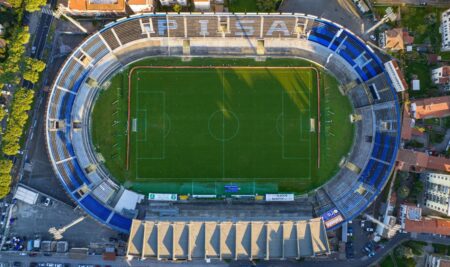The Berlin Senate has chosen a proposal from O+M Architekten and Otto + Richter for the complete transformation of Friedrich-Ludwig-Jahn-Sportpark into a facility that aims to set a benchmark for inclusivity.
The design competition was announced in February and launched in April, organised by the Senate Department for Urban Development, Building and Housing in cooperation with the Senate Department for the Interior, Digital Affairs and Sport.
The Sportpark’s main feature is Friedrich-Ludwig-Jahn-Stadion, which, with a capacity of around 24,000, is the German capital’s third largest stadium, behind the Olympiastadion and Stadion An der Alten Försterei.
First opened in 1952, the Sportpark has been the subject of much debate over its long-term future. The Senate in February said it would be developed into an “inclusive sports facility” in order to give people with and without disabilities equal access to practicing and experiencing sports.
The Sportpark, and in particular the stadium, are currently deemed to have significant functional deficiencies. Due to numerous safety-related structural defects, the stadium had to be temporarily closed in January 2021 and can only be used to a limited extent since it reopened in summer 2021.
The stadium will be redeveloped to a capacity of 20,000, while also being intended to be suitable for second or third tier football. The ramparts that characterise the location, developed from the rubble of the destruction caused in Berlin by World War II, will largely be preserved.

The new stadium will be fitted into the ramparts at the site of the existing venue. The winning design follows a clear wish from the public to preserve and integrate formative components and elements of the existing building.
Its exterior will be characterised by glass, greenery and the red of the current stadium facade. Further sports facilities, such as additional football and beach volleyball courts, tennis courts and a multi-sports hall, along with the construction of a conference centre, are also planned for the Sportpark.
The first phase of the design competition saw 24 participating planning teams submit their ideas and concepts. In August, the jury selected 15 teams to further develop their designs by November.
State Secretary for Building and Housing, Christian Gaebler, said: “The large stadium and the Sportpark are to be supplemented by numerous new sports facilities and converted into the first fully inclusive sports facility.
“The inclusive sports park is intended to be a meeting place for spectators, athletes and recreational athletes. It took a long time to achieve this goal and the design selected will make the stadium and the Sportpark fit for the future with its implementation.”
The project will be divided into three construction phases. The first will see alternative sites upgraded for use while the Sportpark is out of action, with demolition commencing on the existing stadium.
The second phase will see the construction of the new stadium, along with the open space in its immediate vicinity. The final phase will involve completion of the wider Sportpark. A targeted completion date has been set for 2027. The cost of converting the stadium had been placed at €97m (£84.6m/$103.1m) in May 2019, but this is expected to have risen since then.





